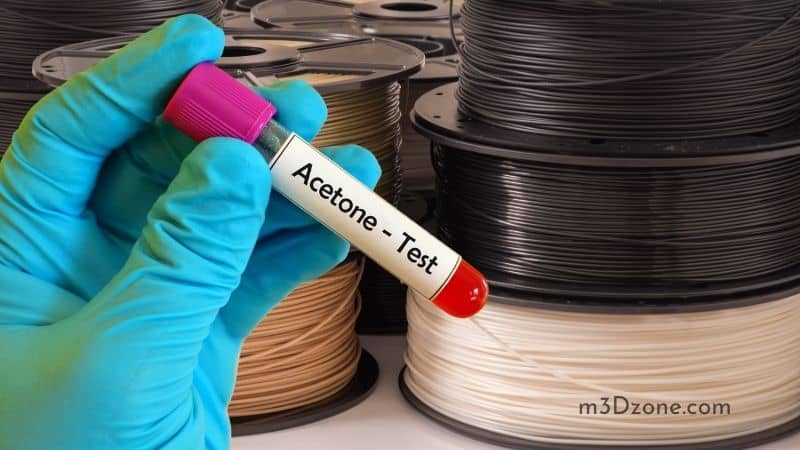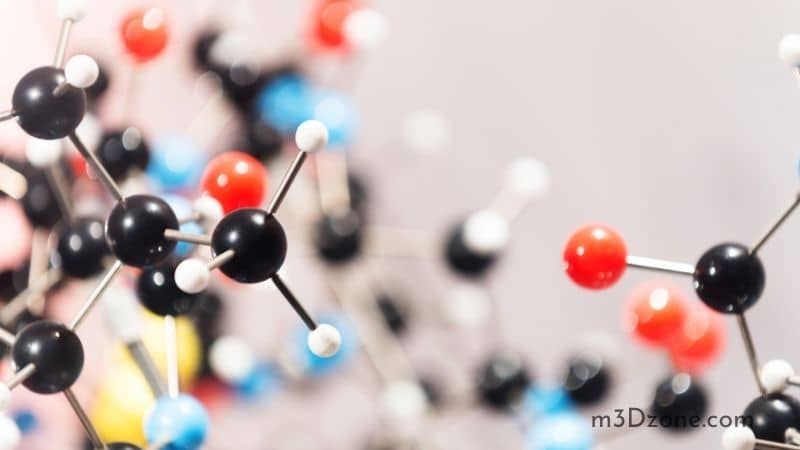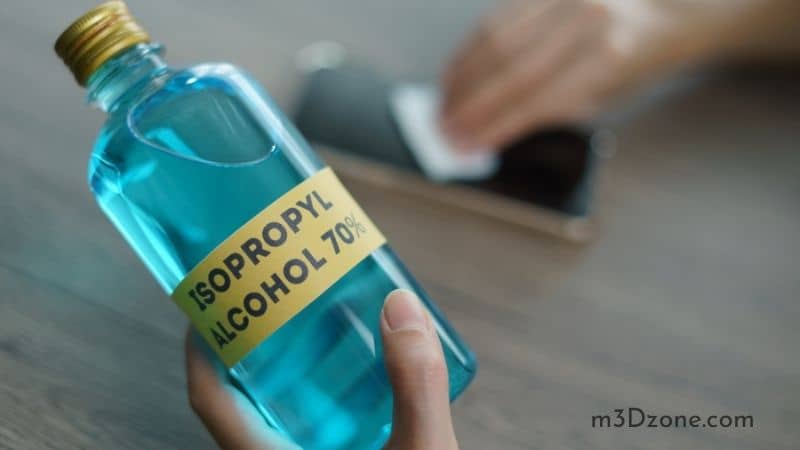A lot of people have been asking if acetone will dissolve PLA plastic. Acetone is a popular choice for removing 3D-printed parts from the build plate and clean up.

It is true that acetone dissolves PLA at a certain level. There are some conditions, however, in which it can be used to dissolve PLA material. While there isn’t one particular solvent that does the job for all types of PLA filament, it is possible to get good results with some other solvents. Acetone’s not so good for dissolving PLA completely.
Quick Navigation
- Can You Dissolve Polylactic Acid (PLA)?
- When Do We Need to Dissolve PLA?
- Does PLA Filament Dissolve in Water?
- Why Acetone Could Dissolve PLA
- Helpful Tips for Dissolving PLA
- PLA 3D Prints Soaked In Acetone Chemical Reaction [VIDEO]
- Other Solvents That Can Dissolve PLA
- Can Isopropyl Alcohol Dissolve PLA?
- How to Melt PLA Filament?
- PLA as a Support Material for PETG
- Conclusion
Can You Dissolve Polylactic Acid (PLA)?
Yes, Polylactic acid (PLA) is soluble. Polylactic acid can be dissolved using methyl ethyl ketone, acetone, ethyl acetate, tetrahydrofuran, and/or caustic soda.
In general, all these chemicals react with PLA. Most substances will dissolve polymers, often depending on the concentration.
When Do We Need to Dissolve PLA?
Before we answer this question, let’s see how ABS benefits from being soluble in acetone. You could smooth ABS prints via acetone dissolution. ABS can be subjected to an acetone vapor bath. As for the process, it only takes a few minutes and requires little effort.
For smoothing PLA prints, the most common way is sanding. This process is technically easy but is an activity that takes a lot of time and manual effort. If you had to dissolve multiple PLA prints, you would surely appreciate having a less tedious alternative using a solvent.
PLA dissolved in an appropriate solvent can be used to bond two pieces of PLA together, fill gaps or cracks, or even join parts. That is the same concept as in ABS, which can dissolve in acetone.
Being able to dissolve PLA can come in handy when cleaning nozzles clogged with PLA residue. The key to cleaning the remaining PLA from the print bed after it has cooled is using a suitable solvent.
The heavy use of acetone in 3D printing makes it worth exploring whether or not this chemical can dissolve PLA. If this solution proves unsuccessful, are there any other solutions we can try?
Does PLA Filament Dissolve in Water?
There are always safer options than using solvents and it is important to choose water whenever possible. Water is a solvent, commonly referred to as the “universal solvent.” It can bind with compounds in a process called hydrolysis.
However, depending on a number of factors makes it difficult to determine how long this process will take.
PLA’s water-soluble properties make it a biodegradable material – a key property for PLA applications. Around the world, 3D printing companies are increasingly using biodegradable polylactic acid filament as an environmentally friendly alternative to plastic.
However, this has become a major source of debate recently with research suggesting that PLA may not be so bio-friendly after all.
In theory, PLA should be able to dissolve into water. However, breaking down a polymer like PLA to its monomers via hydrolysis is an extended process. Most of you are wondering: Is it possible for water to dissolve PLA within a reasonable time frame?
People have already done some water solubility experiments with PLA. Two approaches were particularly interesting:
- One user kept a PLA print in a cup of water for 3.5 years without exposure to light by putting it away from direct sunlight and other sources of UV rays. After 3,5 years the PLA print retained good durability and was almost the same color as before.
- Another 3D printer user submerged several discs of PLA in a 70 °C water bath with constant mixing. After seven days, he noticed, that all of the PLA discs were cracked and broken apart. However, they were still solid.
Based on these results, it appears that temperature and circulation are key factors in dissolving PLA in water. It will take several days before the significant dissolution of PLA occurs. This experiment proves that water is not likely to dissolve PLA prints.
Why Acetone Could Dissolve PLA
Since we learned that water is a limiting solvent for PLA, let’s switch the conversation to acetone. The question remains: Does acetone dissolve PLA? Acetone is a solvent that is used regularly at homes, in businesses, and in labs. In 3D printing, acetone uses are mainly for dissolving or smoothing ABS.
Chemical Compatibility
Acetone is theoretically a compatible solvent with Polylactic Acid (PLA). This is due to the fact acetone is a chemical solvent and PLA is an organic polymer.
Lactide (the monomers of PLA) solubilizes in acetone. It follows the “like dissolves like” rule of chemistry.
The real-world application of this concept is not that simple. When lactide monomers come together to form a polylactide polymer, they become much more chemically stable.
While in this form, PLA can no longer be easily dissolved by acetone. When PLA shifts from an amorphous to a more crystalline structure, it becomes even more stable.
3D printing enthusiasts have tried using acetone to dissolve PLA filament without success. The final product is often a PLA texture that has been replaced by something rubbery and seems to split apart along the layers. There was no absolute dissolution, nor were line-smoothing layers.
The Effect of Molecular Weight
Researchers in 2013 conducted a promising study that explored the use of low molecular weight PLA as a delivery system for ovalbumin adsorption in vaccines. To make this work, nanoparticles made of PLA had to be created using the solvent displacement method.

Using Poly(lactic acid) (PLA), which has an average molecular weight of 9.3 kDa, the researchers could completely dissolve 50 mg of PLA in 10 mL of acetone.
This experiment works because lower molecular weight polylactic acid (PLA) polymers consist of smaller polymer chains. This structure makes them more susceptible to chemical attacks by solvents.
Unfortunately, most PLA resins sold in the market have relatively high molecular weights. The numbers vary, but they are in the range of 50 and above.
This type of filament is ideal for 3D printing as it also gives PLA, a polymer commonly used in printers, enhanced strength, and flexibility. However, if you can find a PLA filament with low molecular weight, that would be a good candidate for acetone dissolution.
Helpful Tips for Dissolving PLA
If you’re using acetone for dissolving PLA, there are a few safety precautions that may be necessary. Keep in mind that acetone is still a solvent at room temperature and flammable.
Safety
Make sure to wear nitrile gloves and a breathing mask as you handle the acetone.
Ventilation
Exposure to acetone fumes becomes a problem if it happens often and is at very high levels. If you have a reaction to chemicals or dust, make sure to work in a room with good ventilation.
Time
You should always keep your exposure time to a minimum when working with acetone. Every precaution should be taken when using PLA in an acetone solution. You need to make sure that any room you place the glass container in has adequate ventilation.
Flammability
Acetone is a highly flammable liquid or gas that burns quickly and can generate thick smoke if it comes into contact with an ignition source.
Make sure there are no sources of ignition in the same room when working with acetone. To avoid electrical risks, you might want to unplug any unnecessary devices.
PLA 3D Prints Soaked In Acetone Chemical Reaction [VIDEO]
Other Solvents That Can Dissolve PLA
1. Tetrahydrofuran (THF)
Tetrahydrofuran (THF) is one of the few solvents compatible with polylactic acid. You can brush it directly on the surface of the PLA print because it is quite effective in removing layer lines. You’ll likely have to do this several times before you get good results.
Keep in mind that THF is quite a powerful solvent and a highly toxic chemical. Handle it with caution. Wearing gloves, goggles, and breathing protection is an over-the-top way to stay safe.
2. Chloroform
Chloroform or dichloromethane is a chemical used primarily for vapor treatment of PLA in 3D printing.
Chloroform fumes are hazardous and could cause cancer. A fume hood is the best way to avoid personal injury, but you can also do this in a room with excellent ventilation.
3. Ethyl Acetate
Ethyl acetate is a far safer alternative to THF or chloroform. One option for the treatment of polylactic acid (PLA) is a vapor bath, which typically yields results.
The fumes coming off of ethyl acetate can result in respiratory irritation and nausea. You should use a vapor bath in an area with good ventilation.
4. Sodium Hydroxide
Finally, caustic soda or sodium hydroxide can be used to dissolve PLA completely. This material dissolves PLA supports used in ABS printing. The very high pH in a caustic soda solution encourages the chemical reaction of PLA with NaOH.
All compounds in this list are hazardous materials that can irritate the skin, eyes, and respiratory system.
Can Isopropyl Alcohol Dissolve PLA?
There is a type of PLA whose formulation makes it soluble in isopropyl alcohol, a much less dangerous product than acetone or methylene chloride.

The Polymaker product is quite easy to use because it smoothes out and removes excessive roughness on your surface without any effort put into it. This brand’s PLA, called Polysmooth, is printed like regular PLA and has the same properties.
How to Melt PLA Filament?
The best way to smooth or dissolve PLA is to use Ethyl Acetate. This chemical has been proven effective and it can be found in most hardware stores.
Keep in mind that it is potentially carcinogenic and teratogenic, and even more so when it’s absorbed through the skin.
PLA as a Support Material for PETG
It is possible to use PLA as an alternative support material for PETG. Since the two materials do not bond strongly, PLA is more likely to slip away easier. This process can be done on a single extruder or multiple extruders.
Conclusion
There is no general agreement yet on which solvent dissolves PLA best. While acetone does have potential, there are still other factors to consider. In addition, the molecular weight of the polymer material and its crystallinity are significant factors.
You may instead choose solvent mixtures that contain other solvents, such as THF (tetrahydrofuran) or ethyl acetate. These solvents are also quite hazardous and not as readily available as acetone. If you plan on doing solvent treatment for PLA, make sure to work with the proper safety gear and procedures.
Recommended Reading
Is BLtouch Worth It? Is Auto Bed Leveling Worth It?
Is BLtouch worth it? BLTouch sensor device serves to ensure that the auto bed leveling feature of your 3D printer works effectively. Find out more!
3D Printer vs. Laser Cutter
A laser cutter works by cutting away material to create an object vs a 3D printer works through an additive process where objects are created by adding layers.
How to Start 3D Printing
There's more to beginning a 3D printing venture than getting the necessary materials. So, how to start 3D printing? Follow this useful guide and find out!
